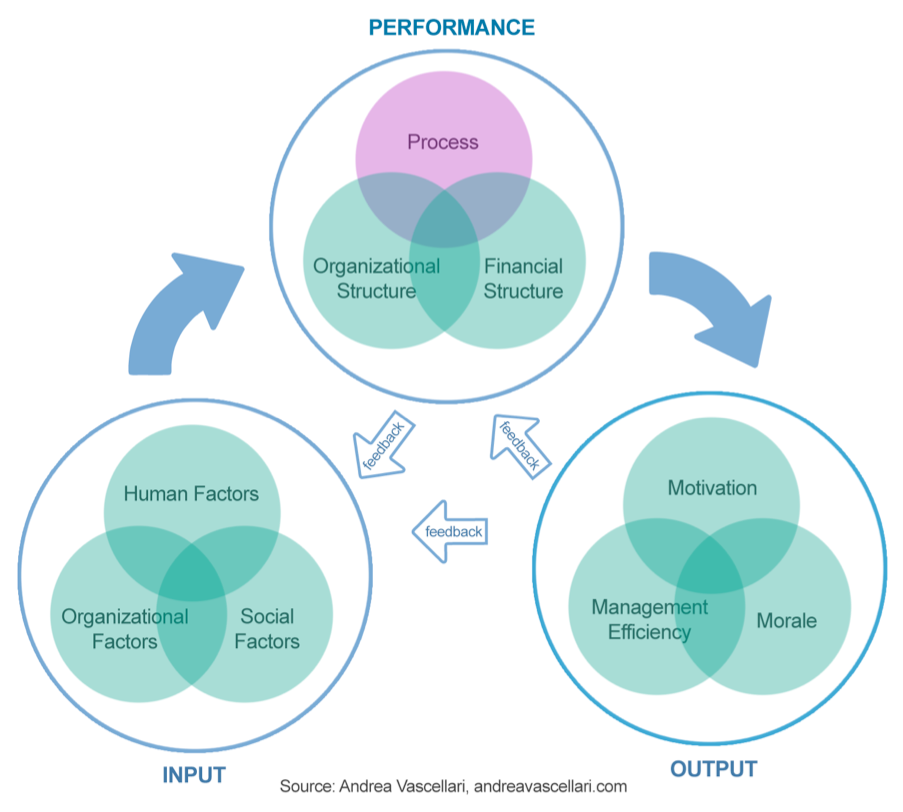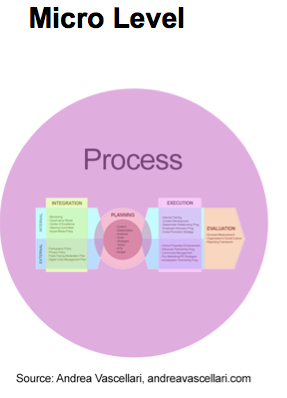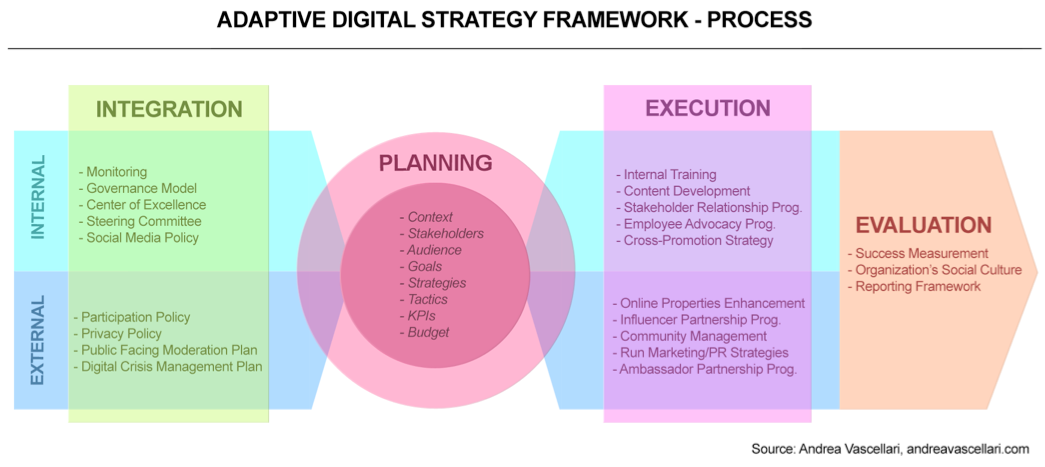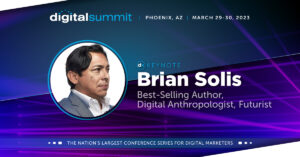Guest post by Andrea Vascellari. You can follow him on Twitter @vascellari and visit his website at www.andreavascellari.com.
Today we still see a large number of organizations that keep struggling to align social media and new emerging communication technologies with the overall firm strategy.
Organizations should adapt, look in the mirror and recognize that they need to change because the world has changed. They should embrace new strategic frameworks to avoid getting caught up in the digital hype that hit them every day with new solutions and focus on what can actually help them achieve their business and communication objectives.
Having worked in communications for a while now, I spent a lot of time studying, piloting and learning from many different communication plans. I understood what works, what doesn’t, where digital fits into the current mix and I understood which are the elements of a plan that are, almost constantly, overlooked by organizations.
Eventually over the years I developed, and kept improving, an adaptive framework that would help me planning, executing and managing digital communication plans more effectively and efficiently. I called this framework the “Adaptive Digital Strategy Framework”.
This post explores the overall structure and process of this framework. We will understand how it functions and, indeed, why it’s called “adaptive”.
Structure and Process
In this ever-changing environment characterized by the disruptive effects of the social web, I learned that there’s no “one best way” to organize and lead an organization. Instead, the optimal performance and results depend on the process adopted by the organization to plan and execute its initiatives, and by the multitude of factors that influence it.
This is why I divide the framework in two parts. The first one defines, at a macro level, where the process lies within the overall ecosystem structure. The second describes, at a micro level, how the process actually functions.
Macro Level
Often people make a mistake when they think exclusively about the process used to plan, execute and manage a communications plan without contextualizing it. This macro bird’s-eye view helps us understand where the process is, what is connected to, what factors it is influenced by and what outcomes it generates.
INPUT
- Organizational factors: Conditions of the external environment/climate and leadership style.
- Human factors: Skills, knowledge and character of who works for the organization.
- Social factors: Values, inspiration, behaviors of the groups of people that work for the organization.
PERFORMANCE
- Organizational structure: This is about how the different activities, tasks and responsibilities are distributed within the organization.
- Process: The brain and heart of our strategic planning & execution. Here we set the objectives, the strategies, the tactics, we verify the results and determine the necessary corrective actions.
- Financial structure: It defines how the financial resources are allocated according to the defined objectives.
OUTPUT
- Management efficiency: Quality of the management. Is the management capable of achieving a good and tangible output?
- Motivation: This is what drives a person to perform a certain action or to pursue a certain objective.
- Morale: Do people feel under pressure when they work or do they feel satisfied? You can think it as the “organizational climate” and it has to do with how the work environment is perceived, directly or indirectly, by the employees.
Micro Level
Now that we have a clear view of where the process fits into the equation, let’s zoom in and understand how it actually works.
It’s not easy to plan and coordinate a digital project, there’s so much to consider. The online world has brought new opportunities but also a whole new set of factors that must be taken into account. So, how should we look at these new variables? And, most importantly, which are the elements that we don’t have to forget when crafting our digital strategy plans?
- Integration: The focus is on how the organization is structured around social efforts and on how social technologies are integrated with communication channels across the organization.
- Planning: Goals are impossible to achieve without a plan. Whether you are working on a PR or a marketing initiative, a good plan is meant to serve as a roadmap. It’s essential for aligning the resources and prioritizing the actions of the organization as it strives to achieve its goals.
- Execution: Execution is what actually brings the strategic plan to fruition. This is the result of the planning decisions made by the organization and its team.
- Evaluation: The overall process, the financial and the human resources must be evaluated to ensure that the communications function is successful. Accurate measurement is vital for the deployment, maintenance and refinement of ongoing and future projects.
- Internal & External: This model includes what needs to be identified, deployed or reviewed at each stage of the development process internally and externally – external communication is as important as internal communication, they are both vital for an organization’s identity and goals achievement.
Adaptiveness of the model
Needs change depending on the nature of the projects (marketing or PR, public or private etc.) so not all the elements I listed are always necessary. For the same reason, keep in mind that you can include additional elements that may have to be taken into account in different/specific contexts.
This is why this framework is defined as “adaptive”. It’s a solid digital strategy framework that keeps transforming in synergy with the present and future evolution of business.
As you can see, in addition to the classic components that characterize traditional communication plans, I included also elements that are starting to play a relevant role in strategic digital communications. Over the next weeks I will release a series of posts on my blog that will explore each element of the “Adaptive Digital Strategy Framework”. In each post I will share my point of view and I will be willing to hear what you think, what you agree or disagree with, what’s missing or what can be changed. It’s going to be a good opportunity to learn from each other and to grow together.
Together with each post of the series I will release also a podcast episode in which you will find the audio version of the post with additional audio commentary about the discussed topics. The name of the podcast is “FIR On Strategy with Andrea Vascellari”, a new podcast under the For Immediate Release (FIR) brand, that offers you guidelines and tips to help you plan, execute and manage your strategic communication plans. The first episode is already available!
Over to you
This framework is based on my experience, what would you adjust based on yours? What do you think about it? Is there something irrelevant? Is something missing? Looking at the sector you are working in, would you approach this differently? Let me know in the comments.
Andrea @vascellari
Image Credit: Shutterstock








![While AI learns and gets smarter and smarter, I spend my time preparing for the future by… [fill in the blank].
The most important skills of the future are human…
#creativity, #imagination, #individuality, #criticalthinking, #empathy
bit.ly/LifescaleBook 💫
Artist: @asiersanznieto
#promptengineering #prompting #ai #genai #artificialintelligence #keynotespeaker #motivationalspeaker #motivational #motivation #education #learning #leadership #leader](https://briansolis.com/wp-content/plugins/instagram-feed/img/placeholder.png)
Ideally, context informs process. Ideally, circumstance shapes action. A subtle mind understands this, a compassionate heart delights in it. Great article, Andrea!
Thanks for the feedback, Nathaniel. I’m glad you found it valuable!
nice article
Thank you, I’m glad you found it interesting!
Andrea @vascellari
Andrea and Brian –
Thank you for sharing. This is an excellent model for organizations of all sizes to determine what sections are most appropriate to their business. The ability of this model to adapt to present and future situations adds flexibility and relevance in planning while increasing its meaning to the firm. I am a big fan of process and this is a great tool.
Best —
Mark Burgess | @mnburgess
Mark,
Thank you for your feedback! Future posts of this series will help you understand how each element functions. I’m sure you will find it interesting.
Andrea @vascellari
Excellent and in-depth article. Thanks for sharing. Are you working on a book about this model?
Hi Jose,
I’m working on a series of high quality posts entirely dedicated to strategic communication plans. I will keep releasing new posts on my blog, I hope you will subscribe and stick around!
The idea of a book though, is not bad at all. By releasing a book I could also include all the inputs that I will receive from readers/listeners. I will definitely keep it mind.
Thank you for your feedback and I hope you will enjoy the upcoming posts of this series!
Andrea
Quite honestly, you’re basically writing a book with your in-depth blog post series. When you’re done, you’ll have a good amount of it done — and at least the outline. Best of luck to you! I’ll be following.
Thanks, Jose! Let’s stay tuned…
Not to be flip, but, Input, Performance, Output…
Where’s the customer? Where are the results (or lack thereof)?
I found this post very interesting. I’m currently in an Integrated Marketing Communications class and we try and learn how best to use all the tools we have available to make a good marketing plan. I feel like this is such a great way to look at things and it really covers a lot. I agree though that everything really has to be tailored to the situation and plan. No two plans will ever be the same and they’re going to be constantly changing. Having a plan that is adaptive is the only way to get the results you’re looking for. Great article.
Kristen Williams
Interesting insights. Really liked the article!
This was a great article and really showed me a different perspective of how to approach digital strategy. One big thing that I agree with is the adaptive aspect. Digital media, in particular social media, changes so much and the companies and people that consistently align their goals with the current platforms and adapt to the changes will be the most successful. I couldn’t agree more with three macros concepts. At the end of the day, digital media is changing every day and will be completely transformed and different 5 years from now than what it currently is. If there’s one thing that I have learned, it’s that companies that stick to a digital strategy and assume that it will always translate to any platform, will end up failing in some way. Thank you for this great framework- it’s a great tool to use when beginning to formulate a digital strategy.
Andrea,
Excellent piece! I couldn’t agree with you more. I read this post for a class I’m taking at UCLA. AND I’m so happy I did! I currently own a business with 10 locations. I have been looking for an article like this to help me drive home a point to my partners that if we don’t adapt and focus on current platforms that pertain to us as well as look to coming ‘digital media’ we will be left behind.
Thanks!
David